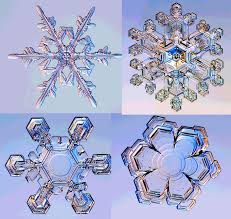It’s winter where I live. Already we’ve had some substantial snows. Whenever I walk through snow or gaze at mounds of snow piled high near driveways and parking lots, I always remember: “It’s nothing more than flakes! Millions and millions and millions of tiny, little snowflakes!”
 Though a heavy snow can impede walking, close schools, and cause highways to shut down, snowflakes themselves are very pretty and very fascinating. Much of what I share here today I gleaned from Kenneth Libbrecht, a physicist at Caltech who has devoted years to studying snow crystals (another term for snowflakes). He is originally from North Dakota where, he says, “Snow wasn’t just part of the landscape; it was part of our heritage.” His book, The Snowflake: Winter’s Secret Beauty, contains not only some of his research, but also many beautiful pictures of real snowflakes by photographer Patricia Rasmussen. Some of her photos accompany this reflection.
Though a heavy snow can impede walking, close schools, and cause highways to shut down, snowflakes themselves are very pretty and very fascinating. Much of what I share here today I gleaned from Kenneth Libbrecht, a physicist at Caltech who has devoted years to studying snow crystals (another term for snowflakes). He is originally from North Dakota where, he says, “Snow wasn’t just part of the landscape; it was part of our heritage.” His book, The Snowflake: Winter’s Secret Beauty, contains not only some of his research, but also many beautiful pictures of real snowflakes by photographer Patricia Rasmussen. Some of her photos accompany this reflection.
Throughout history snowflakes have intrigued people. The first medieval scientists to examine snowflakes, for example, were so amazed by their symmetry that they wondered if they had souls! French philosopher and mathematician Rene Descartes (better known for his dictum, “I think, therefore I am”) studied snowflakes and was impressed by their geometrical perfection of form. In the early 17th Century the famous German scientist Johannes Kepler also scrutinized snowflakes—without the aid of a magnifying glass. One of the first books devoted to snowflakes was published in 1864 by a woman, Frances Knowlton Chickering, a minister’s wife from Maine. She examined snowflakes as they fell on her windowsill and quickly cut paper outlines of their various forms. In the 1880’s a Vermont farmer named Wilson Bentley began taking actual photographs of snowflakes, a project that became his life-long passion. In the course of 46 years he took over  5,000 pictures of snowflakes! He also began to catalog snowflakes. In the 20th Century the Japanese snow-crystal researcher Ukichiro Nakaya continued the classification. Today scientists tell us there are 80 different kinds of snowflakes. The classification chart looks something like the Periodic Table. Here are a few more facts about snowflakes that I found particularly interesting.
5,000 pictures of snowflakes! He also began to catalog snowflakes. In the 20th Century the Japanese snow-crystal researcher Ukichiro Nakaya continued the classification. Today scientists tell us there are 80 different kinds of snowflakes. The classification chart looks something like the Periodic Table. Here are a few more facts about snowflakes that I found particularly interesting.
1) “A snowflake is a temporary work of art,” says Libbrecht. To photograph a single snowflake, it must be plucked from the air as it falls and photographed immediately. A fallen snowflake starts to lose its shape within minutes or even seconds.
2) The real mystery of snowflakes is how they are formed into such complex and symmetrical shapes. Science has not yet solved that mystery. Some people mistakenly think snowflakes are simply frozen raindrops. But that’s not so. That type of precipitation is called sleet. Snowflakes are different. Says Libbrecht, “Snowflakes are the product of a rich synthesis of physics, mathematics, and chemistry.”
3. Is it really true that no two snowflakes are alike? Libbrecht says yes. He explains why. Here’s the condensed version: A typical snowflake contains a billion billion water molecules. In addition each snowflake follows a different path to earth which creates their unique design. So the chances of finding two snowflakes exactly alike are nearly impossible. He says, “It could snow all day and all night until the sun dies before two snow crystals would be exactly, precisely alike.”
4. How are snowflakes formed? Clouds are the nursery for snowflakes. Ice crystals form in clouds when the temperature is below freezing. As they move through the cloud, they bump  into other ice crystals. This process of bumping into each other plus the changes in temperature and humidity they experience as they fall to the earth cause their complex and unique designs. (I see a metaphor here: our beauty and uniqueness too are the result of our particular life’s journey—a journey that includes a lot of “bumping” into each other and experiencing many significant changes along the way!)
into other ice crystals. This process of bumping into each other plus the changes in temperature and humidity they experience as they fall to the earth cause their complex and unique designs. (I see a metaphor here: our beauty and uniqueness too are the result of our particular life’s journey—a journey that includes a lot of “bumping” into each other and experiencing many significant changes along the way!)
5. The snow manufactured at ski resorts is not composed of snowflakes. Rather their “snow” is really sleet. Ask skiers. They can feel the difference.
6. “Snowflakes are diminutive ice sculptures,” says Libbrecht. He is in awe of the “creative genius” that is capable of designing snowflakes in an endless array of beautiful patterns. I think we would call that creative genius God!
So, the next time you are tempted to complain about snow, consider the snowflake. In fact, the next time you’re surrounded by a gentle snowfall, grab a magnifying glass, go outside, and observe a few flakes close up. And while you’re there, catch a few flakes on your tongue or lie down on your back and flap out a snow angel or two!
How do you feel about snowflakes or snow?









13 Responses
Beautiful reflection Sr. Melannie!
Our area recently has 2′ of snow over three days. A little scary! Thanks for the reminder that snow can be beautiful. I sometimes forget snowflakes can be wonderful as I put on all those layers of clothes.
Happy Advent!
Kathleen
I always learn something new from your blogging dear Sr. Melannie! Thank you for all the time and effort you expend as it is surely a gift to us.
I love snow…especially newly fallen snow. There is a quiet in the air when it visits us and that helps me reflect on how Our Lord came to us that first Christmas morning; in quiet and peace.
Blessings
Nancy Frederico
Well, as you know I “left” the snow when I moved from Cleveland to Texas, at least that’s what I thought! We do still get snow here. I have fond memories of walking in a light snowfall, getting our Christmas tree, sled riding down the NDA hill and even throwing snowballs at a few of our teachers! I love the snow, but I don’t like driving in it. I’ve been given a book called “the hidden message of water” by Masara Emoto, it’s interesting so far and also discussed snowflakes. I’ll let you know how the book is when I finish it. Thanks Sr. Melannie and Merry Christmas.
PS. Please pray for Matthew our youngest who left for the Navy on December 2. Love you.
Thanks, Melannie, for this lovely reflection. I love snow but we don’t always get a lot in Ky.
Marietta
I would miss the snow if I lived in Florida or elsewhere that misses the
seasons of our year…and what a thing of beauty in a snowflake…thanks
for the reminder…let it snow let it snow…
I have to admit I’ve never liked snow. But I try to accept it, and your beautiful reflections are helpful with that!
I’ve always seen each snowflake as a special “I love you” message from God. So, for those that don’t like snow, try looking at it as God saying “I love you” in billions of unique ways.
a quote:” Kindness is like snow; it beautifies everything it covers.”
Kahlil Gibran
Here in Minnesota we have lots of beauty. Blessings of snow.
An area south of Buffalo in New York State recently got seven feet of snow in a couple of days. A bit much for me, lots of shoveling, blowing, plowing, roof raking, etc. NYS thruway was closed for days and many turkeys didn’t make it to their thanksgiving destination. And I bet nobody was comparing flakes to find duplicates. After 78 years, winter is still my favorite season but I will gladly pass on 7′ of snow.
Thanks, Melannie, I’ve always loved snow flakes. The info you shared only enhanced my appreciation.
Really appreciate how you connect science, beauty and Life…
Thank you Sr. Melanie for showing the sacredness of the ordinary. By the way, our little granddaughter was a very special snowflake in her kindergarten program today. What a blessing!
Please send your prayers…
a dear relative recently returned to the family farm…where she grew up… she said she hoped to see the farm covered in snow one last time before she dies. She is peppered with cancer, waiting and wondering about suffering and dying. I pray her passing is as peaceful as an evening walk in the snow. Thank you.